Response of Preferential Flow to Initial Soil Water Content in Coalmining Subsidence Zones Along the Middle Reaches of the Yellow River, China
Abstract
1. Introduction
2. Materials and Methods
2.1. Study Area
2.2. Field Stain Tracing Experimental Design
2.3. Soil Texture and Structure Determination
2.4. Imaging Process
2.5. Characteristic Parameters of Preferential Flow
2.6. Preferential Flow Evaluation Methodology
3. Result
3.1. Cracks Effect on Soil Texture and Structure
3.2. Preferential Flow Pattern
3.2.1. Preferential Flow Pattern in Vertical Profile
3.2.2. Preferential Flow Patterns in Horizontal Profile
3.3. Soil Stained Area Ratio
3.4. Comprehensive Evaluation of Preferential Flow
4. Discussion
4.1. Relation Between Cracks and Preferential Flow Characteristics
4.2. Relation Between Initial Soil Moisture and Preferential fFlow Characteristics
4.3. Further Research Needed
5. Conclusions
Author Contributions
Funding
Data Availability Statement
Acknowledgments
Conflicts of Interest
References
- Beven, K.; Germann, P. Macropores and water flow in soils. Water Resour. Res. 1982, 18, 1311–1325. [Google Scholar] [CrossRef]
- Gerke, H.H. Preferential flow descriptions for structured soils. J. Plant Nutr. Soil Sci. 2006, 169, 382–400. [Google Scholar] [CrossRef]
- Wiekenkamp, I.; Huisman, J.A.; Bogena, H.R.; Lin, H.S.; Vereecken, H. Spatial and temporal occurrence of preferential flow in a forested headwater catchment. J. Hydrol. 2016, 534, 139–149. [Google Scholar] [CrossRef]
- Jarvis, N.J. A review of nonequilibrium water flow and solute transport in soil macropores: Principles, controlling factors and consequences for water quality. Eur. J. Soil Sci. 2007, 58, 523–546. [Google Scholar] [CrossRef]
- Tromp-van Meerveld, H.J.; McDonnell, J.J. Threshold relations in subsurface stormflow: 2.The fill and spill hypothesis. Water Resour. Res. 2006, 42, W02411. [Google Scholar] [CrossRef]
- Beven, K.; Germann, P. Management of water repellency in Australia, and risks associated with preferential flow, pesticide concentration and leaching. J. Hydrol. 2013, 231–232, 384–395. [Google Scholar]
- Vikram, K.; Barkha, C.; Padam, J.O.; Mishra, S.; Md. Azamathulla, H. Experimental study on infiltration pattern: Opportunities for sustainable manage-ment in the Northern region of India. Water Sci. Technol. 2021, 84, 2675–2685. [Google Scholar]
- Wu, Q.H.; Zhang, J.F.; Lin, W.J. Applying dyeing tracer to investigate patterns of soil water flow and quantify preferential flow in soil columns. Trans. Chin. Soc. Agric. Eng. 2014, 30, 82–90. [Google Scholar]
- Energy Information Administration (E.I.A). International Energy Outlook. Washington, DC, USA, 2021. Available online: https://www.eia.gov/outlooks/ieo/pdf/IEO2021_Narrative.pdf (accessed on 27 April 2025).
- Ren, B.P.; Du, Y.X. Strategy of ecological protection and high-quality development in the Middle Yellow River. Yellow River 2021, 43, 1–5. [Google Scholar]
- Wang, X.K.; Peng, S.P.; He, Y.L. Soil moisture evidence of self-restoration in coal mining subsidence area of Shendong Mining area: Gognition based on stable isotopes. Sci. Total Environ. 2024, 951, 175831. [Google Scholar] [CrossRef]
- Xie, X.S.; Hou, E.K.; Zhao, B.C.; Feng, D.; Hou, P. Investigating the damage characteristics of overburden and dynamic evolution mechanism of surface cracks in gently inclined multi-seam mining: A case study of Hongliu coal mine. Environ. Technol. Innov. 2024, 36, 103897. [Google Scholar] [CrossRef]
- Qian, J.Z.; Wang, W.; Ma, L.; Dang, B.; Sun, X. Identification of preferential flow paths by hydraulic tomography compared with tracer test and the groundwater contour map in coal mine water hazard area. J. Hydrol. 2024, 631130816. [Google Scholar] [CrossRef]
- Chen, W.; Li, W.; Yang, Z.; Wang, Q. Analysis of mining-induced variation of the water table and potential benefits for ecological vegetation: A case study of Jinjitan coal mine in Yushenfu mining area, China. Hydrogeol. J. 2021, 29, 1629–1645. [Google Scholar] [CrossRef]
- Yang, Y.; Zhang, M.; Zhang, Y.; Wang, S.; Wang, J. Evaluating the soil pevaoration loss rate in a gravel sand mulching environment based on stable isotopes data. J. Arid. Land 2022, 14, 925–939. [Google Scholar] [CrossRef]
- Long, L.; Liu, Y.; Chen, X.; Guo, J.; Li, X.; Guo, Y.; Zhang, X.; Lei, S. Analysis of satial variability and influencing factors of soil nutrients in western China: A case study of the Daliuta Mining Area. Sustainability 2022, 14, 2793. [Google Scholar] [CrossRef]
- Ghafoor, A.; Koestel, J.; Larsbo, M.; Moeys, J.; Jarvis, N. Soil properties and susceptibility to preferential solute transport in tilled topsoil at the catchment scale. J. Hydrol. 2013, 492, 190–199. [Google Scholar] [CrossRef]
- Hardie, M.A.; Cotching, W.E.; Doyle, R.B.; Holz, G.; Lisson, S.; Mattern, K. Effect of antecedent soil moisture on preferential flow in a texture-contrast soil. J. Hydrol. 2011, 398, 191–201. [Google Scholar] [CrossRef]
- Liu, H.; Lin, H. Frequency and control of subsurface preferential flow: From edon to catchment scales. Soil Sci. Soc. Am. J. 2015, 79, 362–377. [Google Scholar] [CrossRef]
- Demand, D.; Blume, T.; Weiler, M. Spatio-temoral relevance and controls of preferential flow at the landscape. Hydrol. Earth Syst. Sci. 2019, 23, 4869–4889. [Google Scholar] [CrossRef]
- Hu, H.; Wen, J.; Peng, Z.; Tian, F.; Tie, Q.; Lu, Y.; Khan, M.Y.A. High-frequency monitoring of the occurrence of preferential flow on hillsloes and its rela-tionship with rainfall features, soil moisture and landscape. Hydrol. Sci. J. 2019, 64, 1385–1396. [Google Scholar] [CrossRef]
- Xu, J.; Liu, M.; Yi, J.; Zhang, J.; Zhang, H.; Cai, C. Evaluating the soil hydraulic functions of vegetation restoration in a subtroical hilly catchment: Insights from continuous soil moisture monitoring. J. Hydrol. 2024, 629, 130578. [Google Scholar] [CrossRef]
- Allaire, S.E.; Roulier, S.; Cessna, A.J. Quantifying preferential flow in soils: A review of different techniques. J. Hydrol. 2009, 378, 179–204. [Google Scholar] [CrossRef]
- Li, W.L.; Jin, C.J.; Wang, A.Z.; Pei, T.F.; Guan, D.X. Research progress in soil macropore flow. Chin. J. Appl. Ecol. 2007, 18, 888–894. [Google Scholar]
- Kan, X.; Cheng, J.; Hou, F. Response of preferential soil flow to different infiltration rates and vegetation types in the Karst Region of Southwest, China. Water 2020, 12, 1778. [Google Scholar] [CrossRef]
- Xu, T.; He, H.T. Analysis of the influences of surface gully on rock pressure behavior in working face with larger mining height in Shangwan Coal Mine. China Coal 2017, 43, 49–54. [Google Scholar]
- Duan, H.L. Reliable operation on method of ultra-long bundle tube gas collecting in Shangwan Coal Mine. Coal Eng. 2023, 55, 136–140. [Google Scholar]
- Yao, J.J. Characteristics of Soil Preferential Flow and Its Effect on Nutrient Transport in Catchment Scale of Simian Mountain, Chongqing; Beijing Forestry University: Beijing, China, 2018; pp. 26–29. [Google Scholar]
- Jiang, X.J.; Chen, C.F.; Zhu, X.A.; Zakari, S.; Singh, A.K.; Zhang, W.; Zeng, H.; Yuan, Z.; He, C.; Yu, S.; et al. Use of dye infiltration experiments and HYDRUS-3D to interpret preferential flow in soil in a rubber-based agroforestry systems in Xishuangbanna, China. Catena 2019, 178, 120–131. [Google Scholar] [CrossRef]
- Hu, Q.; Li, X.Y.; Shi, H.B.; Chen, N.; Zhang, Y. Residual plastic film exerts dual effects of blocking and preferential flow on soil water movement. Soil Tillage Res. 2023, 227, 105628. [Google Scholar] [CrossRef]
- Zheng, X.; Cheng, J.H.; Zhang, H.J. Characteristics and influencing factors of preferential flow dyeing morphology of two soils in Beijing. J. Soil Water Conserv. 2018, 32, 113–119. [Google Scholar]
- Deng, Y.Y.; Liao, Y.L.; Rong, Q.B. Variations of preferential flow across different aged Chinese fir plantations in northern Guangxi. Chin. J. Ecol. 2025, 44, 389–395. [Google Scholar]
- Van Schaik, N. Spatial variability of infiltration patterns related to site characteristics in a semi-arid watershed. Catena 2009, 78, 36–47. [Google Scholar] [CrossRef]
- Tobella, A.B.; Reese, H.; Almaw, A.; Bayala, J.; Malmer, A.; Laudon, H.; Ilstedt, U. The effect of trees on preferential flow and soil infiltrability in an agroforestry parkland in semiarid burkina faso. Water Resour. Res. 2014, 50, 3342–3354. [Google Scholar] [CrossRef]
- Zhang, D.X.; Zhang, H.J.; Cheng, J.H. Quantitative analysis of preferential flow in slope farmland soils based on multi-index evaluation and fractional dimension. Trans. Chin. Soc. Agric. Mach. 2017, 48, 214–220. [Google Scholar]
- Liu, M.X.; Song, X.M.; Lu, S.G.; Zhang, H.L.; Yi, J. Research on the characteristics of preferential flow movement along varied hillslopes covered with different vegetation in the three gorges reservoir area. Acta Pedol. Sin. 2022, 59, 1321–1335. [Google Scholar]
- Aumer, K.; Stoffregen, H.; Wessolek, G. Seasonal dynamics of preferential flow in a water repellent soil. Vadose Zone J. 2006, 5, 405–411. [Google Scholar] [CrossRef]
- Duan, F.Y.; Zhu, C.L.; Wang, C. Effects of cracking patterns and antecedent soil water content on preferential flow of irrigated water. J. Irrig. Drain. 2023, 42, 32–41. [Google Scholar]
- Chen, X.B.; Wu, H.; Jiang, B. Spatial distribution of preferential flow paths in paddy field in the karst area of Guangxi. Chin. J. Appl. Ecol. 2020, 31, 4099–4108. [Google Scholar]
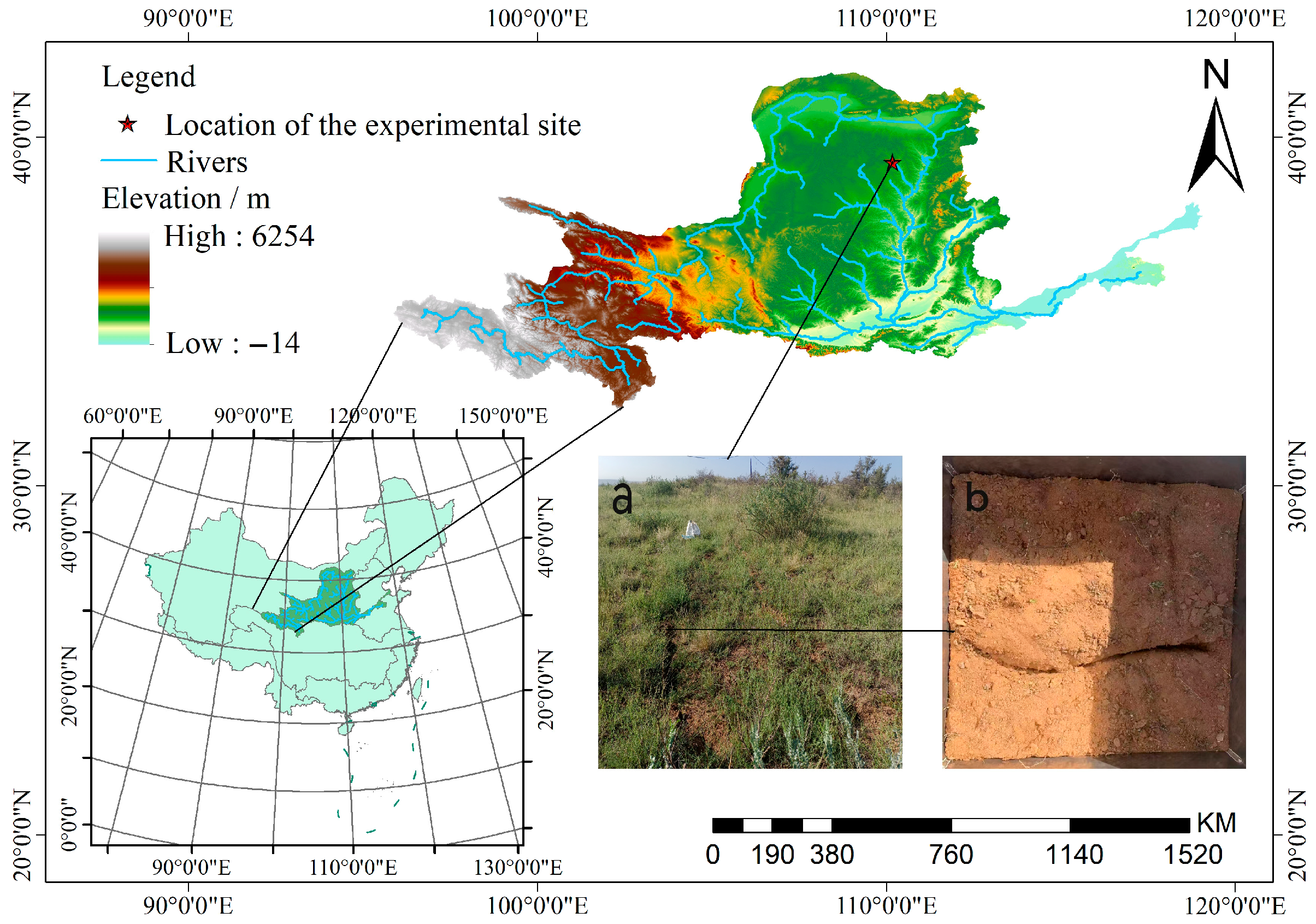

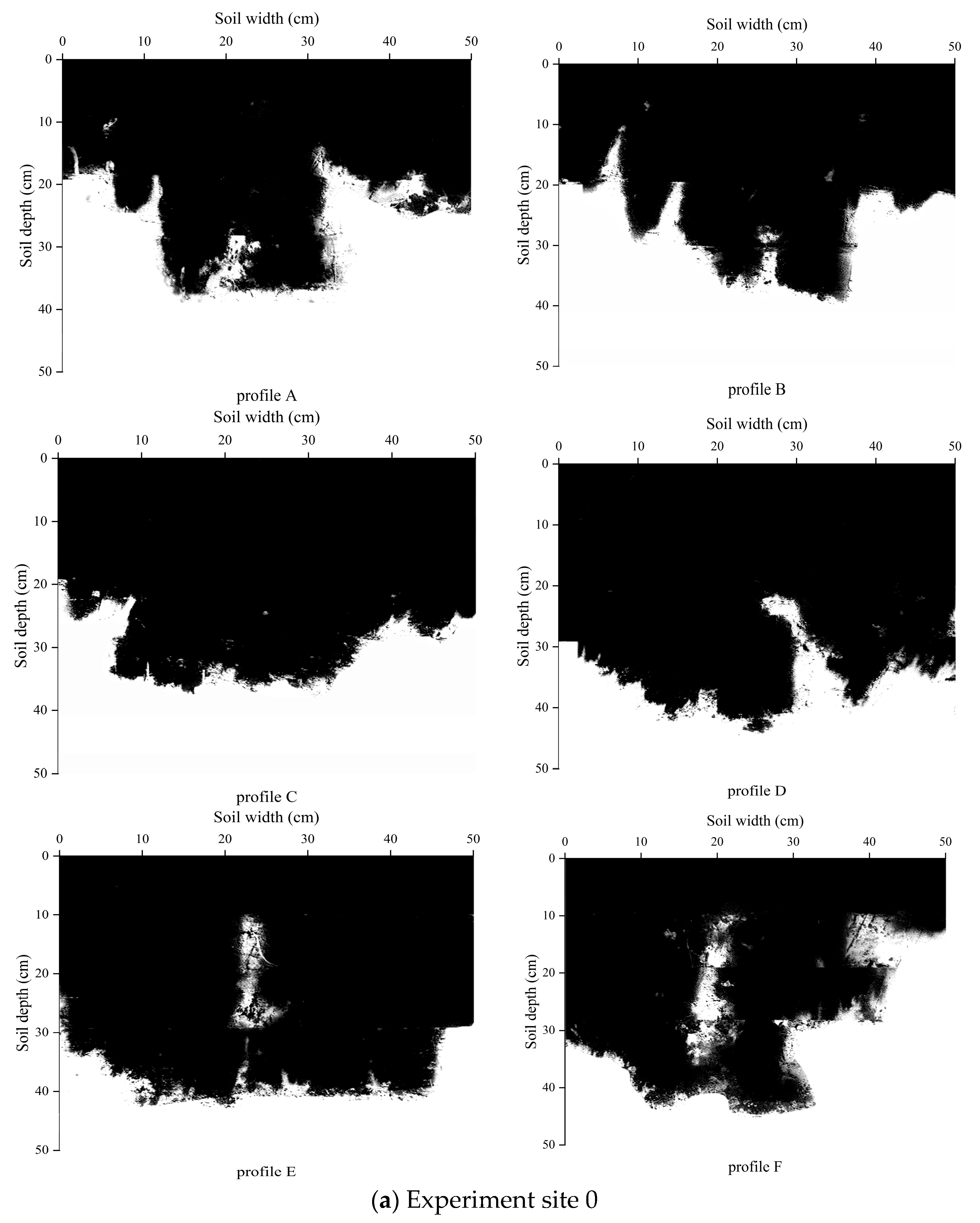
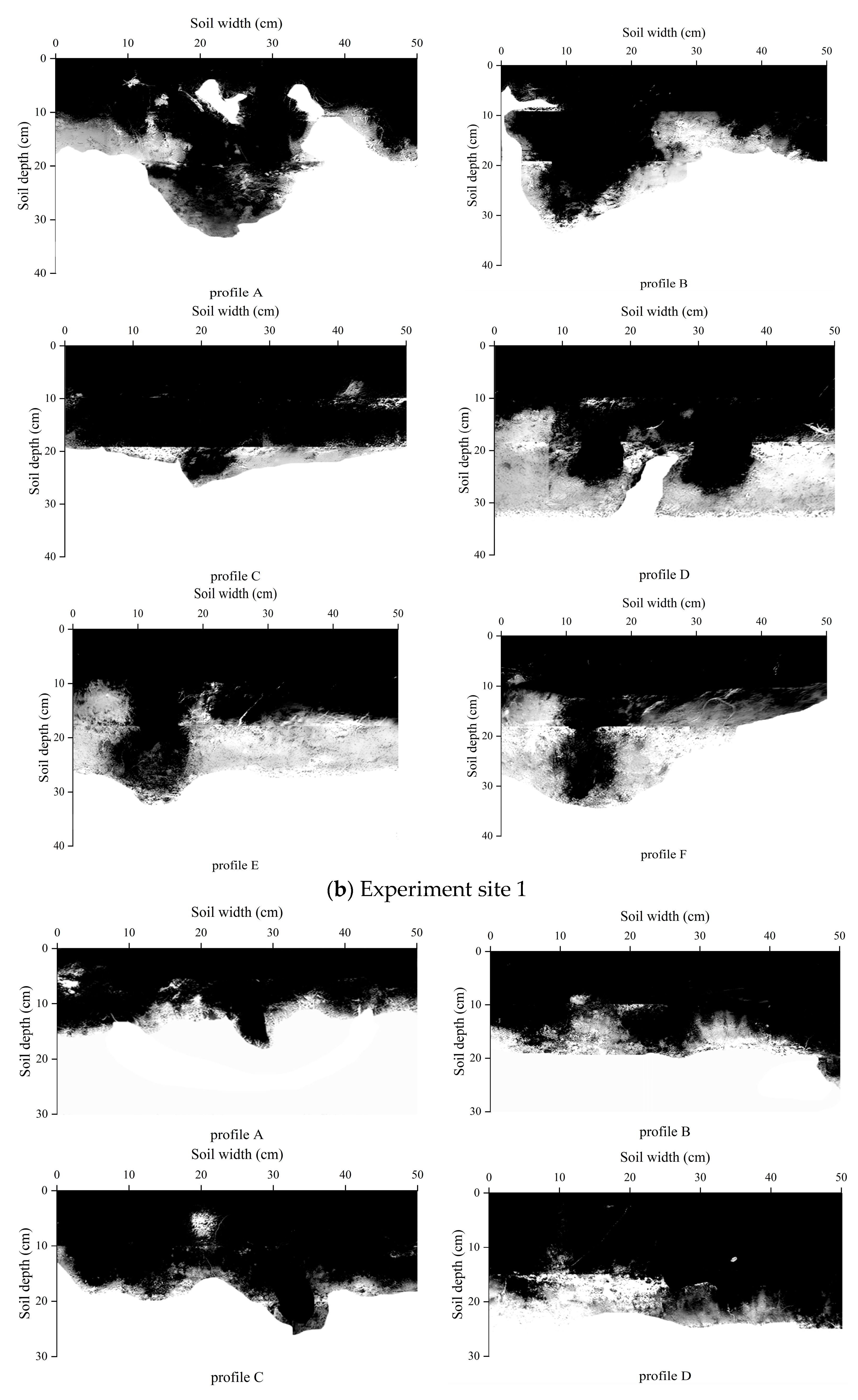
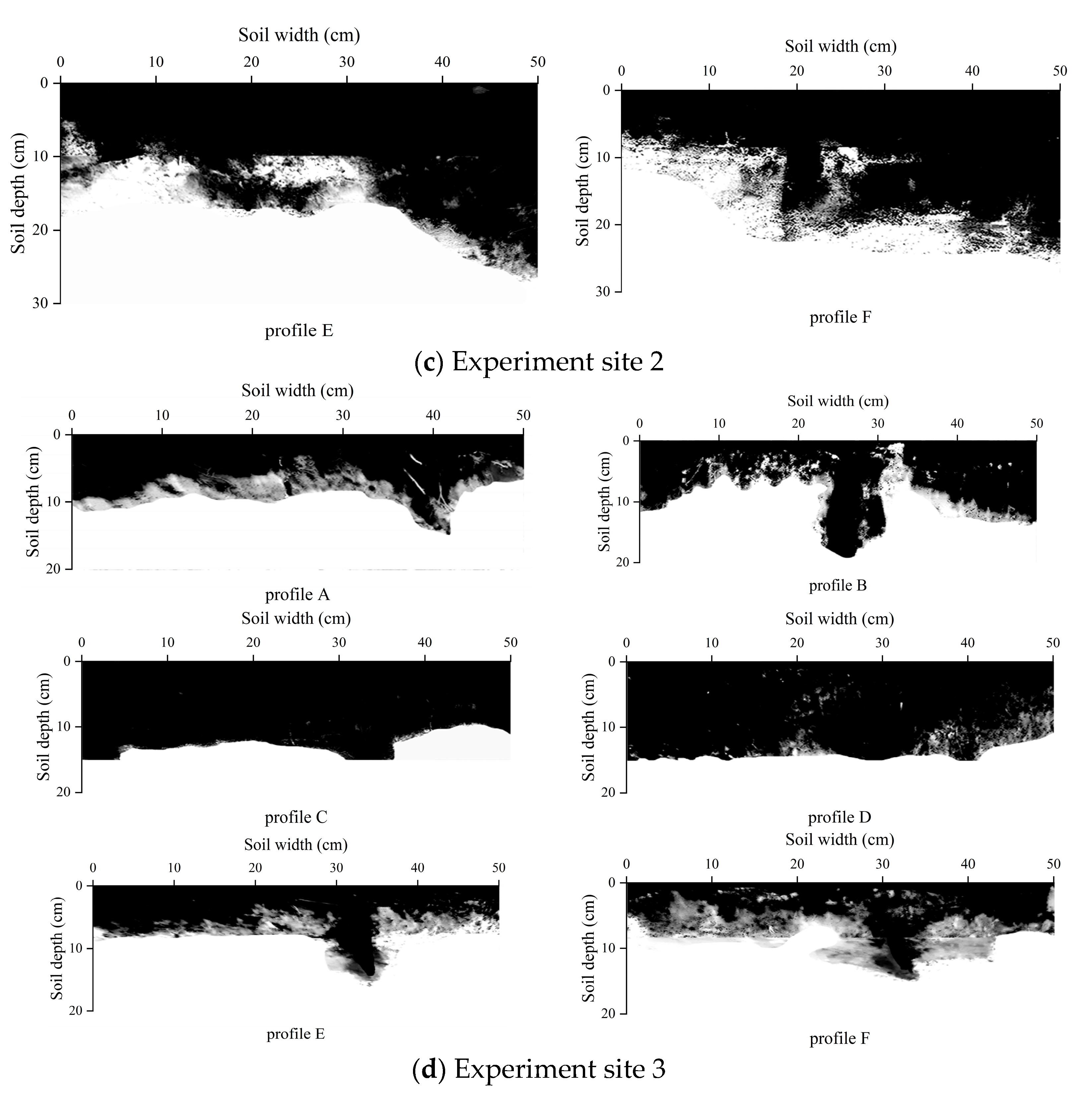
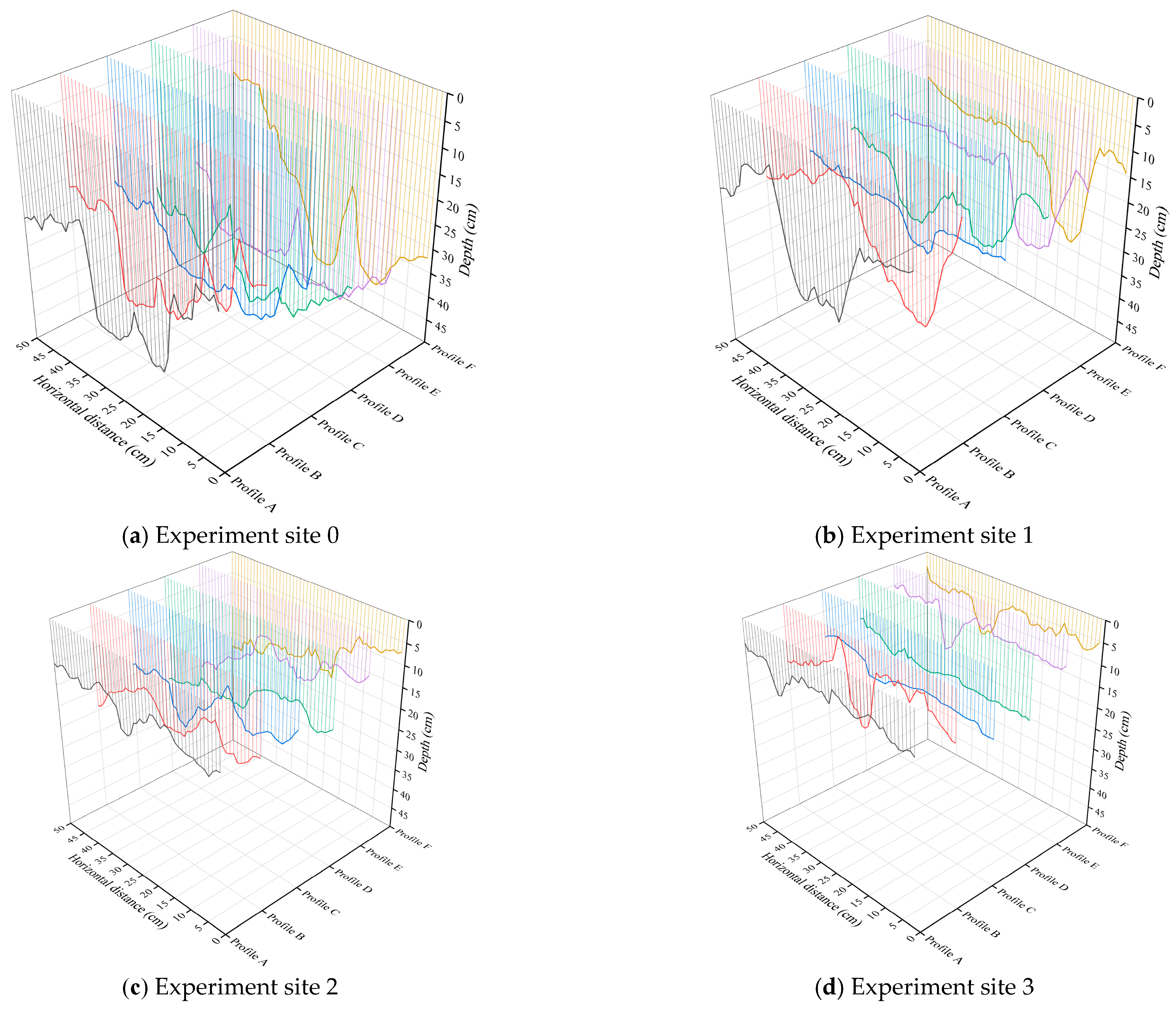
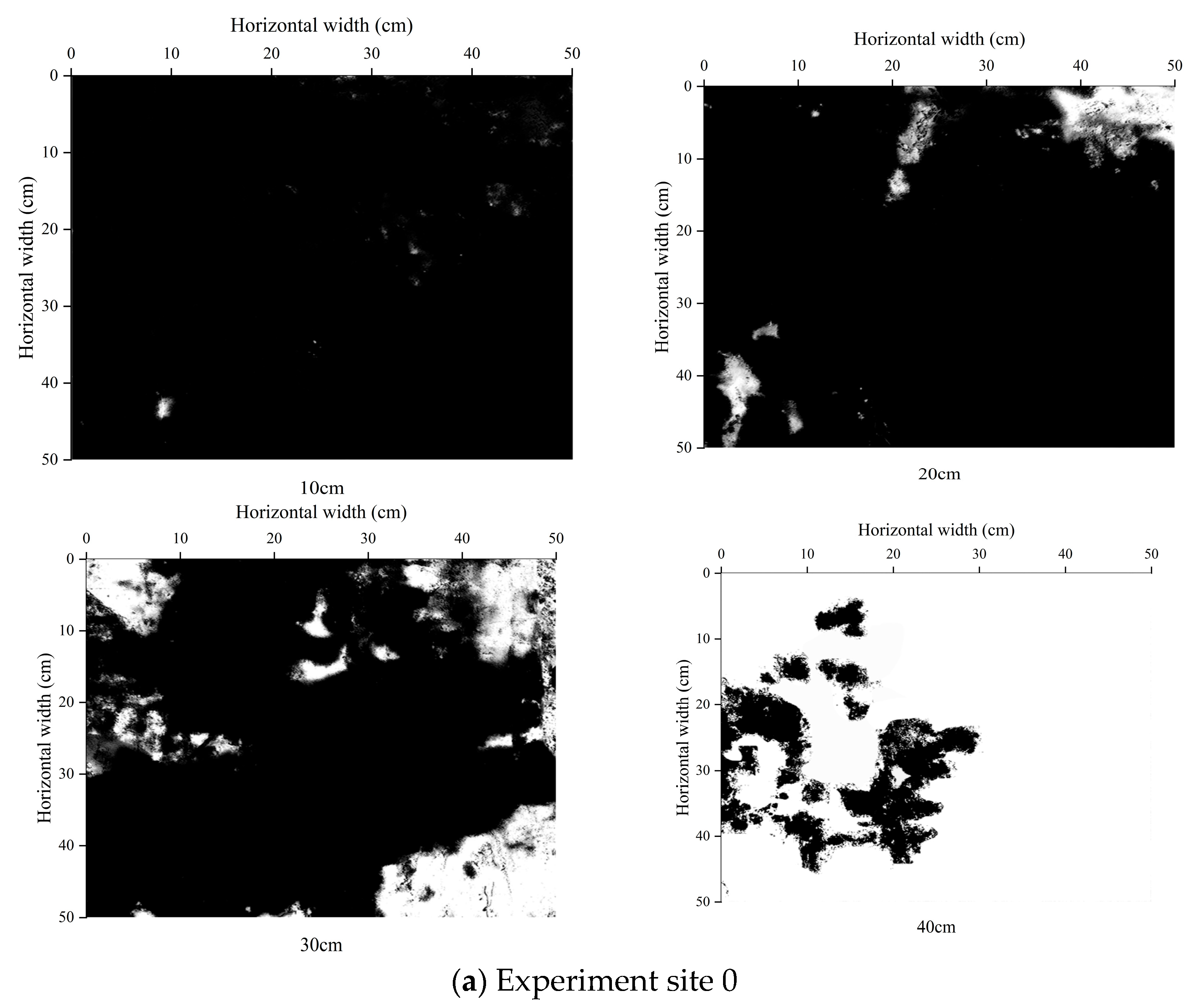
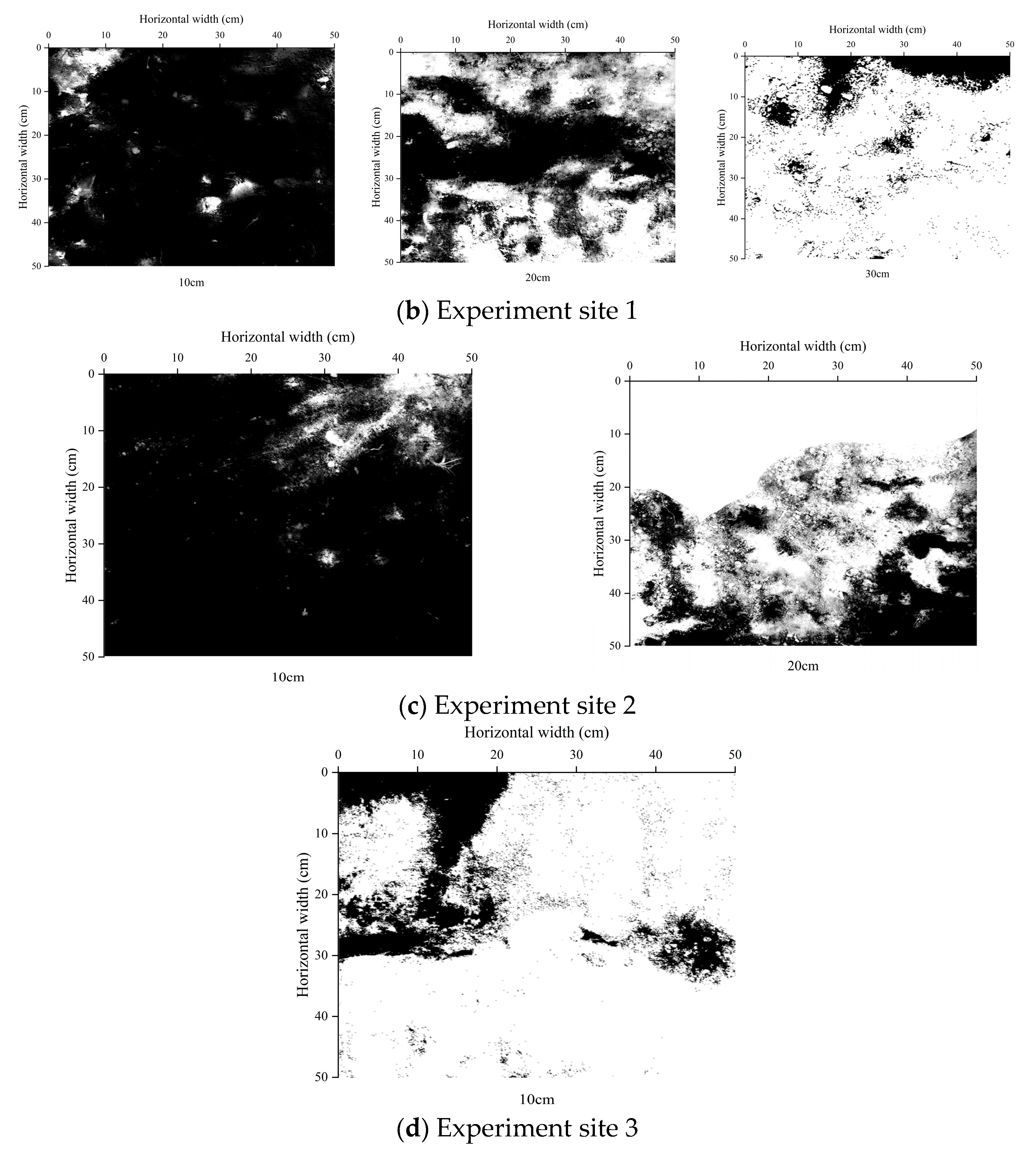
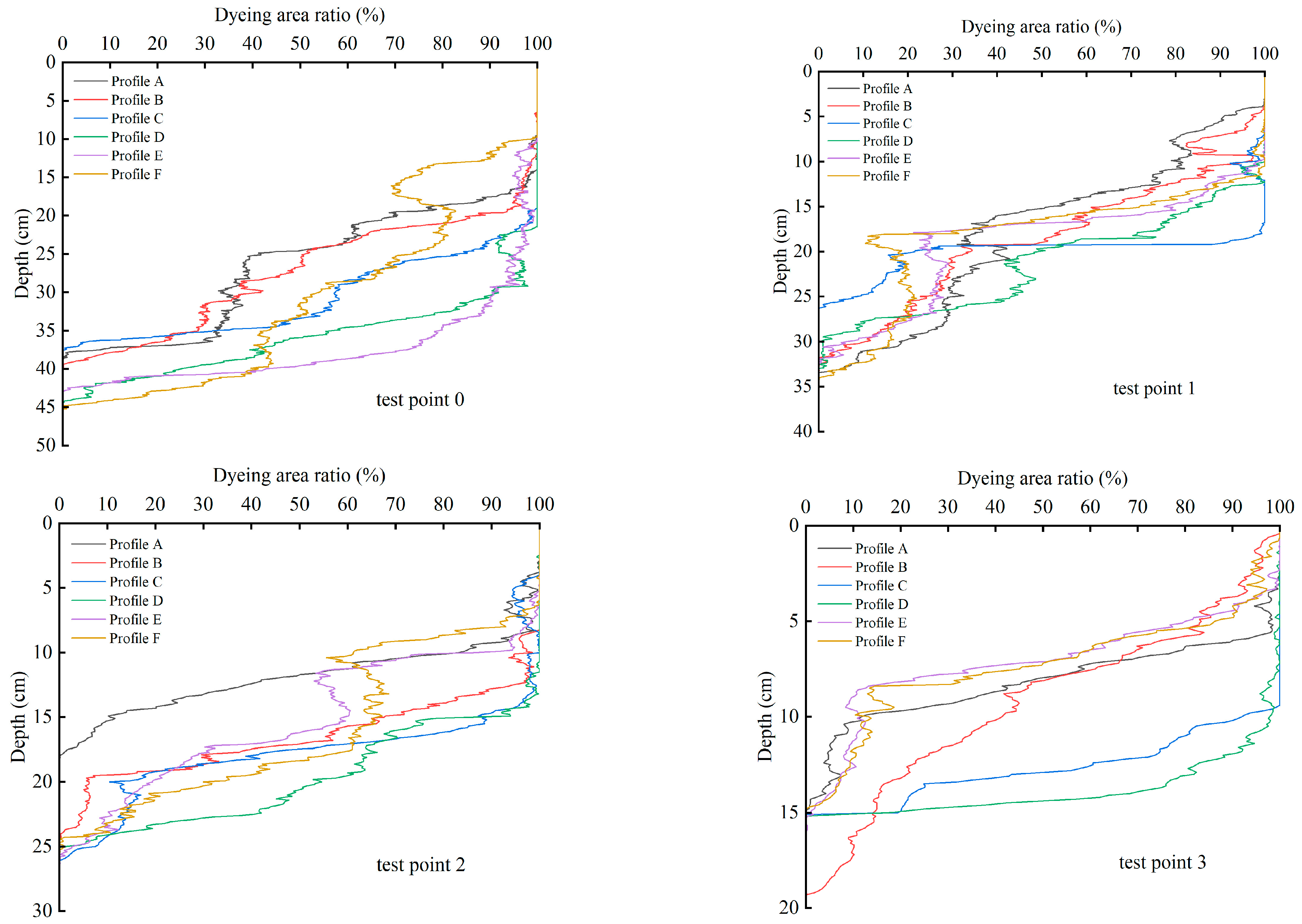
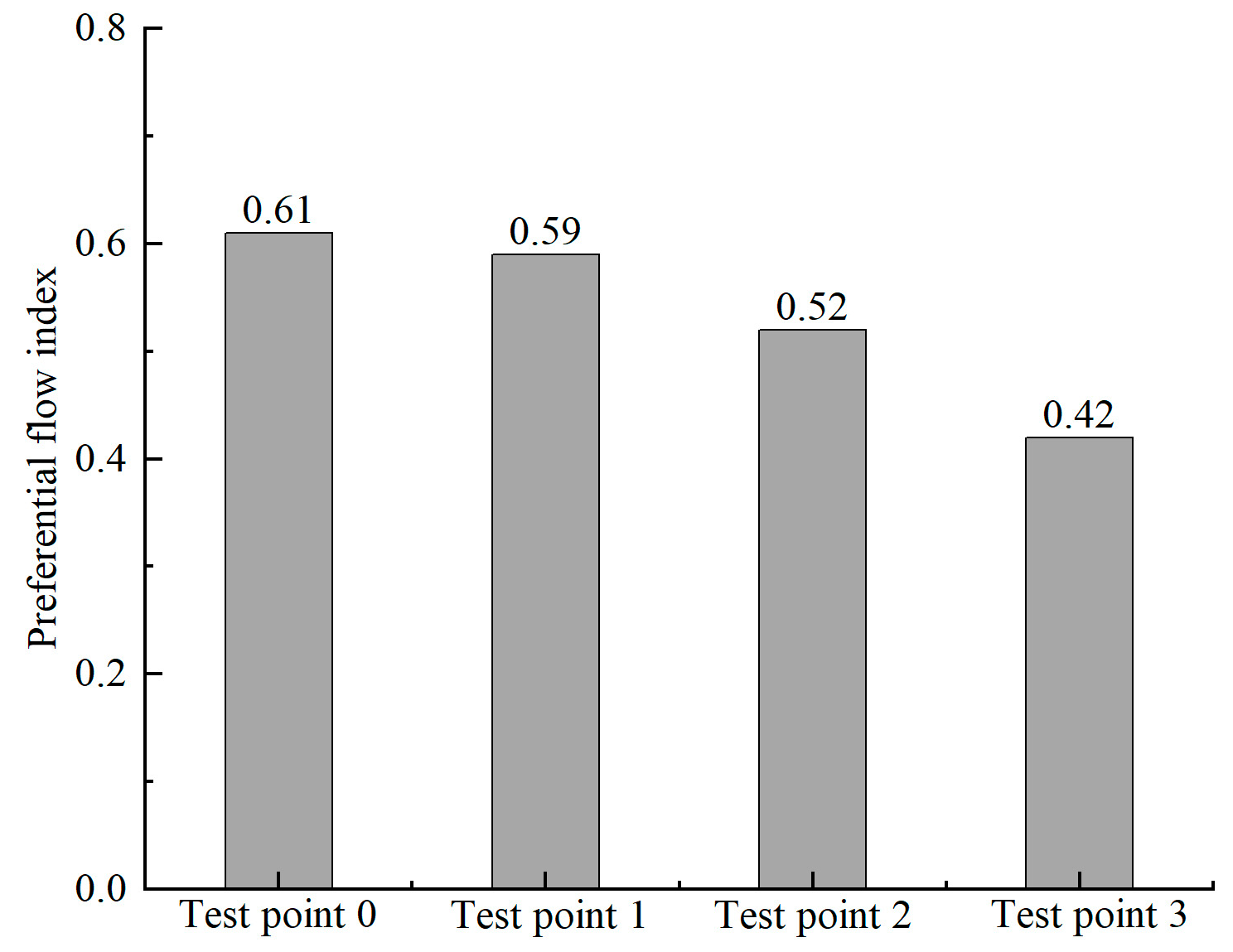
| Experiment Site | Control Condition | Quantity of Brilliant Blue Solution/L | Experiment Design | |
|---|---|---|---|---|
| 0 | Same width crack, different initial soil water content | 22.5 L | Continuous rainfall of 0.5 h at the intensity of 125 mm·h−1 | Irrigation water 0 L, 24 h in advance |
| 1 | Irrigation water 5 L, 24 h in advance | |||
| 2 | Irrigation water 10 L, 24 h in advance | |||
| 3 | Irrigation water 15 L, 24 h in advance | |||
| Experiment Site | Different Soil Depths/cm | Water Content by Volume/% | Soil Capacity /g·cm−3 | Soil Porosity/% | Soil Particle Size > 0.05 mm/% | ||||
|---|---|---|---|---|---|---|---|---|---|
| SA | UA | SA | UA | SA | UA | SA | UA | ||
| 0 | 0–10 | 5.69 | 1.83 | 0.79 | 1.05 | 66.95 | 59.77 | 91.78 | 92.17 |
| 10–20 | 4.23 | 2.41 | 0.87 | 0.99 | 66.66 | 62.11 | 92.23 | 90.73 | |
| 20–30 | 4.89 | 3.09 | 0.99 | 0.99 | 62.25 | 62.16 | 90.02 | 91.19 | |
| 30–40 | 7.88 | 4.01 | 1.11 | 1.09 | 67.96 | 57.55 | 89.13 | 88.07 | |
| 1 | 0–10 | 6.54 | 3.35 | 1.04 | 1.28 | 60.65 | 59.84 | 93.12 | 92.04 |
| 10–20 | 6.74 | 4.15 | 1.06 | 0.98 | 59.51 | 57.62 | 89.32 | 87.29 | |
| 20–30 | 8.41 | 4.54 | 1.25 | 1.21 | 62.21 | 53.72 | 92.76 | 93.11 | |
| 2 | 0–10 | 8.24 | 7.45 | 1.12 | 1.14 | 57.39 | 56.79 | 92.34 | 91.02 |
| 10–20 | 9.92 | 7.96 | 1.27 | 1.01 | 61.43 | 61.21 | 91.26 | 90.25 | |
| 20–30 | 6.66 | 5.95 | 0.97 | 0.94 | 63.23 | 63.89 | 91.34 | 92.40 | |
| 3 | 0–10 | 4.86 | 4.06 | 0.90 | 1.13 | 65.09 | 56.64 | 88.63 | 87.72 |
| 10–20 | 8.69 | 7.05 | 0.75 | 0.98 | 67.93 | 62.06 | 85.61 | 86.03 | |
| Function | Test Point | Functional Relationship | R2 |
|---|---|---|---|
| Exponential function | 0 | y = 189.73e−0.052x | 0.6066 |
| 1 | y = 288.92e−0.12x | 0.6571 | |
| 2 | y = 307.03e−0.15x | 0.6132 | |
| 3 | y = 365.81e−0.256x | 0.7908 | |
| Logarithmic function | 0 | y = −26.12ln(x) + 146.26 | 0.5402 |
| 1 | y = −36.42ln(x) + 152.33 | 0.6992 | |
| 2 | y = −35.47ln(x) + 146.96 | 0.6447 | |
| 3 | y = −41.87ln(x) + 140.05 | 0.7907 | |
| Quadratic function | 0 | y = −0.0718x2 + 1.0709x + 96.77 | 0.9964 |
| 1 | y = −0.0221x2 − 5.9078x + 116.63 | 0.9531 | |
| 2 | y = −0.1459x2 − 0.428x + 105.62 | 0.977 | |
| 3 | y = −0.001x2 − 0.1016x + 102.61 | 0.9711 | |
| Cubic function | 0 | y = −0.0004x3 − 0.0461x2 + 0.5925x + 98.704 | 0.9968 |
| 1 | y = 0.0081x3 − 0.474x2 + 4.0809x + 92.524 | 0.9845 | |
| 2 | y = 0.0128x3 − 0.6824x2 + 5.6901x + 90.058 | 0.9936 | |
| 3 | y = 0.0374x3 − 1.1987x2 + 4.2183x + 96.788 | 0.9932 |
| Test Point | Substrate Flow Depth | Maximum Infiltration Depth | Preferential Flow Ratio | Length Index | Variation Coefficient of Stained Pattern |
|---|---|---|---|---|---|
| 0 | 25.933 ± 6.4936a | 41.400 ± 3.1673a | 0.176 ± 0.0719a | 204.933 ± 38.4072ab | 0.489 ± 0.9956b |
| 1 | 14.417 ± 2.9247b | 32.050 ± 2.9269b | 0.281 ± 0.1362b | 221.067 ± 31.7406a | 0.646 ± 0.1096ab |
| 2 | 12.283 ± 3.1019bc | 24.183 ± 3.0643c | 0.259 ± 0.1302a | 179.733 ± 29.5076b | 0.721 ± 0.1953ab |
| 3 | 7.717 ± 3.4055c | 15.800 ± 1.7146d | 0.257 ± 0.1273c | 136.933 ± 21.2410c | 0.783 ± 0.2847a |
| Each Evaluation Index | Mean Value | Mean Square Deviation | Weight Coefficient |
|---|---|---|---|
| Depth of substrate flow | 0.428 | 0.3622 | 0.209 |
| Maximumdepth of infiltration | 0.552 | 0.351 | 0.203 |
| Preferential flow percentage | 0.441 | 0.331 | 0.192 |
| Length index | 0.497 | 0.313 | 0.181 |
| Variation coefficient of staining pattern | 0.532 | 0.372 | 0.215 |
Disclaimer/Publisher’s Note: The statements, opinions and data contained in all publications are solely those of the individual author(s) and contributor(s) and not of MDPI and/or the editor(s). MDPI and/or the editor(s) disclaim responsibility for any injury to people or property resulting from any ideas, methods, instructions or products referred to in the content. |
© 2025 by the authors. Licensee MDPI, Basel, Switzerland. This article is an open access article distributed under the terms and conditions of the Creative Commons Attribution (CC BY) license (https://creativecommons.org/licenses/by/4.0/).
Share and Cite
Yang, Y.; Guo, Q. Response of Preferential Flow to Initial Soil Water Content in Coalmining Subsidence Zones Along the Middle Reaches of the Yellow River, China. Water 2025, 17, 2606. https://doi.org/10.3390/w17172606
Yang Y, Guo Q. Response of Preferential Flow to Initial Soil Water Content in Coalmining Subsidence Zones Along the Middle Reaches of the Yellow River, China. Water. 2025; 17(17):2606. https://doi.org/10.3390/w17172606
Chicago/Turabian StyleYang, Yunsong, and Qiaoling Guo. 2025. "Response of Preferential Flow to Initial Soil Water Content in Coalmining Subsidence Zones Along the Middle Reaches of the Yellow River, China" Water 17, no. 17: 2606. https://doi.org/10.3390/w17172606
APA StyleYang, Y., & Guo, Q. (2025). Response of Preferential Flow to Initial Soil Water Content in Coalmining Subsidence Zones Along the Middle Reaches of the Yellow River, China. Water, 17(17), 2606. https://doi.org/10.3390/w17172606





